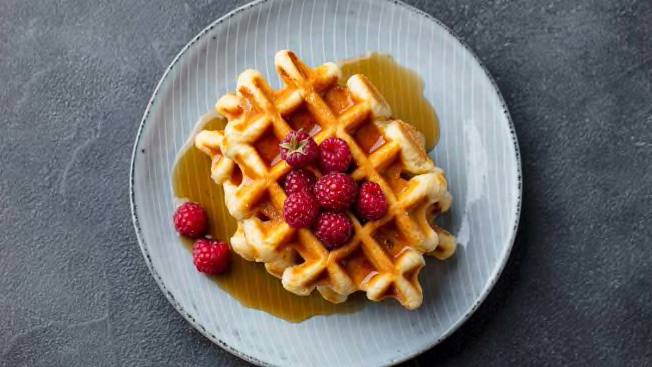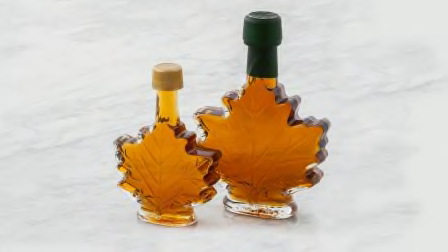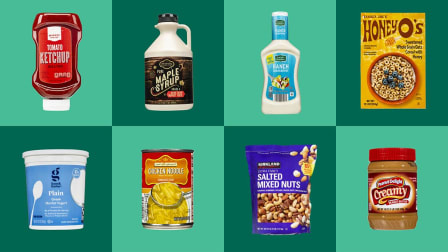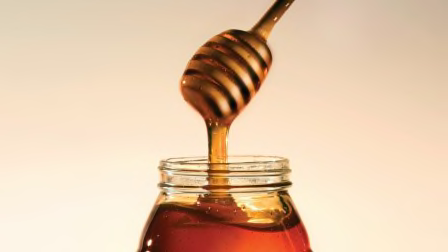Is Maple Syrup Good for You?
We have the answer to that and other common questions about this sweetener
When you shop through retailer links on our site, we may earn affiliate commissions. 100% of the fees we collect are used to support our nonprofit mission. Learn more.

On pancakes, waffles, oatmeal, and more, Americans love maple syrup. The rich flavor is one reason why it’s so popular, as is its reputation as a good-for-you "natural" sweetener. But don’t fall for the sweet talk. While there’s some reason to choose maple syrup over refined table sugar, it’s definitely not a “superfood.” Here, we have the facts on pure maple syrup nutrition and clear up some other common misconceptions.
What’s the Difference Between Maple Syrup and Pancake Syrup?
Although they may sit side by side on grocery store shelves, the two syrups are quite different. Pure maple syrup is actually made from maple tree sap that’s been boiled down to reduce the water content and concentrate the sugars. Those sugars caramelize, resulting in maple syrup’s characteristic rich color and flavor. It takes about 10 gallons of sap to make just 1 quart of maple syrup.
Is Maple Syrup Actually Healthier Than Sugar?
Yes, slightly, because it contains some nutrients. In two tablespoons, you get quite a bit of the mineral manganese and the B vitamin riboflavin, plus small amounts of the minerals calcium, potassium, and zinc. In addition, pure maple syrup contains antioxidants. But 2 tablespoons have 104 calories and 24 grams of sugars, and many other foods have those same nutrients without the high calorie and sugar load.
The sugars in maple syrup are considered "added sugars” in your diet, and keeping your intake of added sugars low is more important than the type of added sugars you eat. The daily limit, according to the Food and Drug Administration, is no more than 10 percent of your daily calories, or 50 grams (about 12 teaspoons) for someone on a 2,000-calorie diet. The American Heart Association recommends consuming even less—no more than 25 grams for women per day and 36 grams for men.
But regulations about how maple syrup’s sugars are listed on Nutrition Facts labels could lead to some consumer confusion.
If maple syrup is an ingredient in a packaged food, such as granola or granola bars, the sugars it contributes will be listed under the "added sugars" line. And if you stir some maple syrup into your oatmeal or pour over pancakes, that maple syrup would count toward your daily added sugars intake.
However, if you look at the Nutrition Facts label on a bottle of maple syrup itself, you won’t see a line that says "includes X grams of added sugars"—but the Daily Value column will list a percentage. Why?
When the FDA set its requirement for manufacturers to list added sugars on Nutrition Facts labels, it had originally intended for maple syrup and other single-ingredient sugars, such as honey or table sugar, to have all of their sugar grams listed as added sugars. However, honey and maple syrup producers pushed back, saying that consumers would think that the products contained sweeteners other than maple syrup or honey when manufacturers don’t add sugar to these products. The FDA agreed but said that producers still needed to list the percentage of the daily value of added sugars supplied by their product so that consumers would know how much it contributed to their daily added sugars intake.
"It is confusing, but the easiest way to think about it is that maple syrup is sugar, so it counts toward your daily intake of added sugars, but it doesn’t contain added sugars," says Amy Keating, RD, a nutritionist and food test program leader at CR.
What Maple Syrup Is Best, Grade A or Grade B?
The traditional system of syrup grades may look like it’s evaluating quality, but it’s not. Grade B syrup has a darker color and deeper flavor than grade A, but that doesn’t make it inferior. In fact, darker maple syrups may have more antioxidants, and many people prefer their more intense flavor.
In 2015, the U.S. Department of Agriculture addressed the confusion about quality when it changed the labeling system for syrup so that it’s in line with international standards. Now all maple syrup is grade A, followed by a color/flavor description:
• Grade A Light Amber is now Grade A Golden Color/Delicate Taste
• Grade A Medium Amber is now Grade A Amber Color/Rich Taste
• Grade A Dark Amber is now Grade A Dark Color/Robust Taste
• Grade B is now Grade A Very Dark Color/Strong Taste
Though the grades don’t reflect variations in quality, they do indicate real differences in flavor. According to CR’s food tasters, both dark and the amber versions have clean maple flavor, but the former is more intense and complex than the latter. You really notice the difference when you taste the amber and dark versions side by side, but whether amber or dark syrup is better is a matter of personal taste.

Photo: Anna Pustynnikova/iStock Photo: Anna Pustynnikova/iStock
Do You Need to Spend a Lot of Money for a Good Maple Syrup?
Pure maple syrup is pricier than pancake syrup, but you don’t need to buy the most expensive one to get a quality product. According to CR’s tasters, less pricey store brands can be as flavorful as more expensive brand names for both amber and dark syrups. And once you pour syrup on waffles or pancakes, any flavor differences are even less noticeable. "That’s why we recommend buying syrup by price," Keating says.
In CR’s tests comparing name brands to store brands, BJ’s Wellsley Farms Organic 100% Pure Maple Syrup had a robust taste as did the brand name Butternut Mountain Farm 100% Pure Vermont Maple Syrup. But BJ’s cost 17 percent less. For those who like a more delicate-tasting syrup, Costco Kirkland Signature Organic Maple Syrup would be a good pick, and cost 25 percent less than the brand.
Does Maple Syrup Go Bad?
Unlike honey, maple syrup can grow mold, so once you open a container you should put it in the refrigerator, where it will last six months to a year. An unopened container can be stored in a cool place for up to two years.
Some brands of maple syrup are sold in different-sized containers, and the syrup is often less expensive per serving when you buy the largest one. While 32 ounces may be more than you can use in six months, you can take advantage of the lower price if you store it in the freezer, where it will keep indefinitely (it won’t freeze solid). For the best flavor, bring maple syrup to room temperature or heat it gently before using it.
Which Waffle Maker?
When it comes to waffle makers, there are a wide range of features and prices available, so we’ve listed (in alphabetical order) three of CR’s top-rated models below.



















